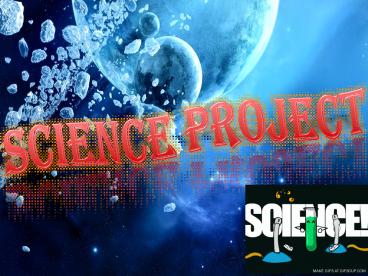Science Project reflect action on sound - PowerPoint PPT Presentation
Title:
Science Project reflect action on sound
Description:
try out its an amazing presentation/............ – PowerPoint PPT presentation
Number of Views:56
Title: Science Project reflect action on sound
1
SCIENCE PROJECT
2
Presentation On
SOUND
3
What is a wave?
- A wave is a repeating disturbance that transfers
energy through matter or space.
- When an object vibrates it causes the particles
around it to move. - These particles bump into particles close to
them, transferring energy possessed. This
continues until they run out of energy.
Longitudinal Waves
Waves transfer energy without transferring matter.
Transverse Waves
4
- Therefore sound can be defined as
- A form of energy caused by vibrations. This
energy is transferred due to pressure through
longitudinal waves.
In a longitudinal wave the matter in the wave
moves back and forth parallel to the direction of
the wave.
5
Sound can be reflected, refracted, and absorbed
and also shows evidence of interference and
diffraction.
Reflection of sound is also be known as echo.
Reverberation of sound is the repeated multiple
reflection of sound in any enclosed space.
Reverberation occurs when the echo produced is as
same/strong as the sound produced by the source.
Refraction of sound occurs when the wave travels
from one medium to another.
6
Wavelength
f
?
Wave Speed
Time period
Wavelength (?) is the distance from the center of
one compression to the center of the next
compression.
Time period (t) is the time it takes for one full
wavelength to pass a certain point.
Frequency (f) is waves per second.
Wave Speed (s) the distance covered by a complete
wave in a given time.
7
- Compressions
- The close together part of the wave.
- RAREFACTIONS
- The spread- out parts of a wave.
Amplitude is the maximum distance the particles
in a wave vibrate from their mean positions.
Amplitude controls the volume and intensity of
sound.
The amplitude of a longitudinal wave is
determined by the closeness of the longitudinal
waves. The closer the longitudinal waves and the
farther the rarefaction lines.
8
Loudness of Sound in Decibels
Sound Loudness (dbs) Hearing Damage
Average Home 40-50
Loud Music 90-100 After long exposure
Rock Concert 115-120 Progressive
Jet Engine 120-170 Pain
9
Speed of Sound
344 m/s in air at 20C
- Speed of Sound depends on
- Type of medium
- travels better through liquids and solids.
- cant travel through a vacuum.
- Temperature of medium
- travels faster at higher temperatures.
10
Example Sound Speeds
Medium Sound speed (m/s)
Air (20?C) 343
Water 1497
Gold 3240
Brick 3650
Wood 38004600
Glass 5100
Aluminum 6420
11
Doppler Effect
- Doppler Effect
- change in wave frequency caused by a moving wave
source.
- moving toward you - pitch sounds higher.
- moving away from you - pitch sounds lower.
12
Interference
Waves interfere in one of two ways Constructive
Interference and Destructive Interference.
13
The Frequency of Sound
- Frequency of a sound wave is heard as pitch.
- highness or lowness of a sound
High frequency High pitch Short wavelength.
Low frequency Low pitch Long wavelength.
14
Low pitch. Eg. Fox horn
High Pitch. Eg. Piccolo
Healthy humans can hear from 20 Hz to 20,000 Hz
Ultrasound - sound waves with frequencies above
the normal human range of hearing. Ultrasonic
sounds have frequencies greater than 20000 Hz.
Infrasound - sounds with frequencies below the
normal human range of hearing. Infrasonic sounds
have frequencies lower than 20Hz.
15
- Some animals can hear sounds with frequencies
greater than 20000 Hz. - a) Dogs (up to 35,000 Hz)
- Bats (over 100,000 Hz)
- Medical diagnosis.
16
Human Hearing
Sound Wave
Vibrates ear drum
Amplified by bones
Converted to nerve impulses in cochlea
17
(No Transcript)
18
THE END
19
(No Transcript)































